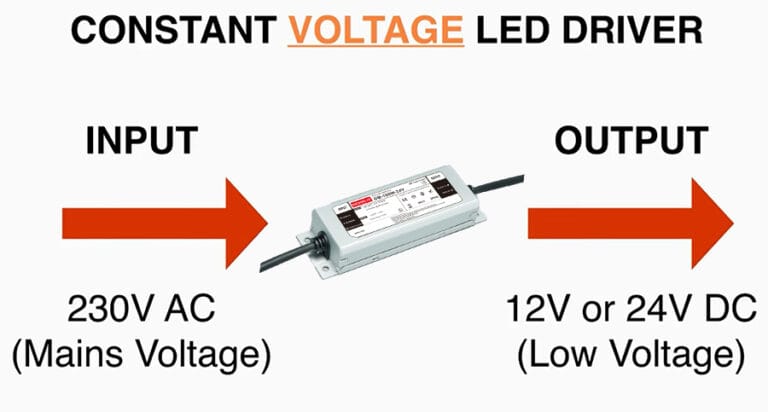Introduction
The LED power supply can convert the 220v AC power into low-voltage power with positive and negative poles, and then supply power to low-voltage equipment. The electronic devices used with the LED power supply are mainly light-emitting diodes (LED). Because it regulates the power which can drive an LED or array of LEDs which requires, it’s normally called an LED driver, and how to choose LED driver?
LED driver is the most important part of the LED light. An LED driver is an electrical device that regulates the power supply of an LED or a string of LEDs. It is a key component of the LED circuit. The LED driver provides the appropriate current and voltage for the LED chips to work properly. LED driver ensures that the voltage and current of the LED chips of LED light remain within its operating range, without being affected by power supply(main supply) fluctuations.
After serveral years led Lighting operation, we found that the most easily damaged part is the LED driver. When it breaks, the light will not work at all, or some of the LEDs will not work, or sometimes the LEDs will flicker. Therefore, it is very important to choose an LED driver. ( Click here to see the LED Driver.
1. Why LED Drivers Matter and how to choose LED driver
LED drivers regulate power supply to LEDs, ensuring stable current, voltage protection, and dimming compatibility. A mismatched driver can lead to flickering, reduced lifespan, or non-compliance with regulations like the EU Ecodesign Directive 2023, which mandates energy efficiency and labeling for lighting products1.
Key Functions:
Current Regulation: Prevents overheating and extends LED lifespan.
Voltage Conversion: Adapts AC to DC for LED operation.
Dimming Support: Enables smart lighting integration (e.g., DALI, 0-10V).
2. Types of LED Drivers
A. Constant Current (CC) Drivers
Best For: High-power LEDs (streetlights, industrial lighting).
Features: Maintains fixed current output (e.g., 350mA–1500mA).
B. Constant Voltage (CV) Drivers
Best For: LED strips, signage, and low-voltage systems.
Features: Delivers fixed voltage (12V/24V/48V).
Our IP67 CV Series supports damp environments.
C. Dimmable Drivers
Best For: Smart homes, offices, and hospitality.
Types: TRIAC, PWM, DALI-2 (mandatory for EU public buildings)8.
Discover Triac/0-10V/Dali Drivers with seamless IoT integration.
3. European Class Standards and Requirements
Europe’s lighting regulations prioritize safety, efficiency, and electromagnetic compatibility (EMC). Key standards include:
A. Energy Efficiency Class (A–G)
Class A: Highest efficiency (e.g., drivers with PF>0.95, THD<10%).
Class E: Minimum compliance under revised EU.
B. EMC Directives
EN 61000-3-2: Limits harmonic currents to prevent grid interference.
CISPR 15: Governs RF emissions for lighting equipment.
C. Safety Certifications
ENEC Mark: Mandatory for EU sales, ensuring electrical safety.
IEC 61347: Specifies LED driver safety and performance5.
D. Class I OR II LED Driver
Normally projects or tenders have a requirement on the protection class of lamps. They will ask for either Class I or Class II for AC input LED street lights. Below is a description of class 1 vs class 2 power supply.
What’s Class I?
Class I LED lamps have basic insulation and must include a protective earth connection to reduce the risk of electric shock. Their safety is achieved through the use of basic insulation, and also provides a means of connecting to a protective earth conductor in the building, where, if the basic insulation fails, route those conductive parts to earth that would otherwise produce dangerous voltage.
What’s Class II?
Class II LED lamps not only rely on basic insulation for protection against electric shock but must also provide additional safety protection measures such as double insulation or reinforced insulation. It is neither dependent on the protective ground wire nor on the installation conditions. This means that Class II LED lights have no terminal/pin for ground connection.
| Classify | Class I | Class II | Class III |
| Insulation | Basic insulation | Double Insulated | / |
| Characteristic | three-wire power cord | two-wire power cord | Solar or others with extra-low voltage |
4. How to Choose the Right Driver?
Follow this checklist to align with European norms and application needs:
Step 1: Define Application Requirements
Environment: Indoor (IP40) vs. outdoor (IP67).
Dimming Needs: DALI-2 for commercial buildings, TRIAC for residential.
Step 2: Verify Compliance
Ensure certifications: CE, ENEC, and ErP Lot 43 (for EU energy labeling).
Step 3: Prioritize Efficiency
Opt for drivers with PF>0.9 and THD<20% to avoid utility penalties.
Our PF0.98 Series reduces reactive power costs by 30%.
Step 4: Assess Thermal Management
Select drivers with -30°C to +70°C operating range for harsh climates.
Summary
Through the above knowledge, I hope you have a certain understanding of the choice of LED drivers. All these factors ZGSM thinks are relatively important. Of course, in addition to these, dimension, over-voltage protection, over current protection, NFC, LED driver efficacy, THD, PF are also factors that need to be considered in the selection of LED power supplies. If you are still worried about the choice of power supply for LED lamps, or you are still thinking about what functions your LED lamps should achieve, you can contact us. We will answer your questions to the best of our knowledge.
Growling Weekly recommendations
Contact info@szgrowling.com to get newst offer sheets now:)



